Well, it's back to normal after the few days of unaccustomed luxury. We are now camped in a corner of a soggy field on the outskirts of Eger. It is raining again which comes as no surprise. It has been our constant, faithful companion throughout our travels but here in Hungary it has excelled itself, never departing for more than twenty-four hours since we arrived.
It was a delight to spend a few days under a real roof in a real bed with a bathroom of our own and the opportunity to wash everything we possess. It was with reluctance that we decided we needed to move on today. It was made easier with István and Ibolya being away for the weekend and we'd said our goodbyes on Thursday night. It hurts saying goodbye to friends so far from England, unsure when or where we may meet again, but we really hope they will now be encouraged to pay a return visit to Exeter before too long.
So this morning we left Debrecen in the rain and made our way along the potholed roads awash with water that we have come to accept as the norm in Hungary towards Tokaj and Eger. Hungary is well known for the quality of its wines and two areas in particular are of world renown, Tokaj and Eger. Tokaj is a very small appellation producing sweet white wines of outstanding quality somewhat similar to Muscat where the grapes are gathered late from the vines after they have been touched and withered by the early winter frosts. Tokaj has recently been included on Unesco's list of world heritage sites because it has always maintained the special traditions of wine-making across the centuries. Eger produces a deep rich red wine called Egri Bikaver, known throughout Europe as Bull's Blood. (Available quite inexpensively at your local wine merchant or supermarket. Look it out and join us in a glass. You'll be really glad you did!)
At Nyíregyháza we stopped to explore and search out some lunch. The rain had stopped leaving everywhere grey and chilly. We really find it hard to believe there are hosepipe bans in Britain and temperatures are soaring! We had much warmer, sunnier weather than this in January down in the south of Spain, and it was only a month ago we were so hot in Venice.
Nyíregyháza turned out to be a pleasant place with some interesting buildings in eclectic style including the town hall and the theatre, both dating from the end of the 19th century. Under Communism the town had been left to decay but efforts have been made, successfully, to revive it with a very agreeable park area and lots of flower beds. Buildings have been restored and painted in bright yellows or oranges and there are statues all around the town. Hungarians love statues - busts, bas-reliefs and sculptures in stone, bronze or wood. Every town is filled with them and many are quite modern and innovative. Most are of people we have never heard of but many are of writers, doctors, poets, national heros and local worthies. Historic leaders are inevitably posed in flamboyant attitudes and look quintessentially Hungarian with magnificent moustaches and high boots! Other statues are just fun and may be allegorical, representing a concept rather than a person. They certainly add interest to any town.
 Town Hall, Nyíregyháza
Town Hall, Nyíregyháza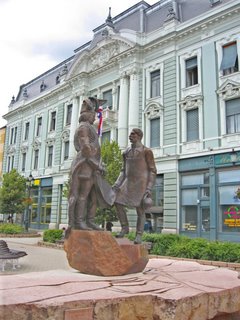 Bronze sculpture, Nyíregyháza
Bronze sculpture, Nyíregyháza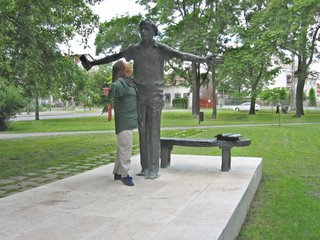 Larger than life figure! Nyíregyháza
Larger than life figure! NyíregyházaWe were presented with a menu entirely in Hungarian by a charming waitress who spoke no English. We began to wish we'd paid more attention to the appropriate section of our phrase book which we had left in Modestine. Ian managed to work it out and Jill was very impressed when everything arrived and was exactly what he'd said it would be! We had chicken with cream and mushrooms served with potato croquets and a cucumber salad for Jill and gipsy-style pork with fried potatoes and mixed salad for Ian.
We continued to Tokaj. As we approached we saw the hill, an extinct volcano, rising gently up from the flat plains. It was the first hill we have seen for days, its flanks laid out with vines. Tokaj turned out to be little more than a very pleasant village on the swollen river Tisza, its entire industry being based on viticulture. It is a very attractive little place with a museum (closed) and the opportunity to visit the Rákóczi cellars. The charge for this was 2,200 forints each to include tastings of four wines. As Jill was driving we asked how much without the wines. It is not that sort of tour we were told. This is a unique experience and the wine-tasting is an essential part. So we didn't bother. Ian would have needed to drink Jill's wines and would have been incapable of navigating! Later we found a tiny place selling some of the cheap Tokai wines. Between us we tried small glasses of a couple of these and found one very palatable despite costing us only 80 forints a glass – around 15 pence! We worked out that it would cost more to use the local public facilities to evacuate the wine than it did to consume it! We then bought a 2 litre plastic bottle of the stuff for 800 forints (around £2) and are just as satisfied and a lot richer than we would have been on the tour even if the wines are not the same quality.
 Traditional wood sculptures, Tokaj
Traditional wood sculptures, Tokaj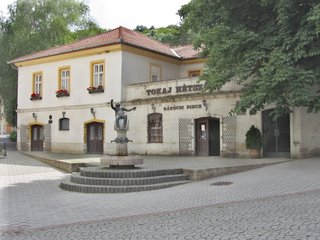 Bacchus outside the Rákóczi cellars, Tokaj
Bacchus outside the Rákóczi cellars, Tokaj Main street, Tokaj
Main street, TokajStill having quite a way to drive we headed on to Eger, a town of 65,000 people. It seems very pleasant but will have to wait until tomorrow to be explored. The campsite on our map had been closed down but we found another one on the edge of town. Because of the rain the shower block is flooded and there are too many school children and drunkards around to make it perfect but we are used to these little inconveniences now. It has been pouring all evening but we are warm and comfortable in Modestine who stands peacefully under the trees with water pouring down her flanks. We have consumed a bottle of Eger wine between us and this has anaesthetised us to the outside world.
Sunday 11th June 2006 Eger, Hungary
If you took up our suggestion that you should buy some Egri Bikaver or Bull's Blood at the local off-license, and if you still have any left, pour yourself a glass to enjoy as you read about Eger, its place of origin. We are currently camping right in amongst the vines on the hills to the north of Hungary and the cellars in which the wine is matured in wooden casks are cut into the hillside on the lane at the gate of the campsite.
Quite contrary to our expectations the day dawned bright, warm and sunny. By the time we were up the worst of the wet had drained away. The noisy teenagers left as we were sitting drinking breakfast tea outside and all the old retired crumblies like us, from Denmark, Holland, Germany, France and Italy heaved a collective European sigh of relief as peace descended on the campsite.
Later we walked the short distance into the centre of the town which we found delightful and in festive mood. We have spent the entire day wandering the pretty streets of the town, exploring the many, splendidly restored baroque buildings, the wonderful neo-classical cathedral, the castle walls above the town and the huge network of disused wine cellars beneath it. Eger in the sunshine is complete perfection.
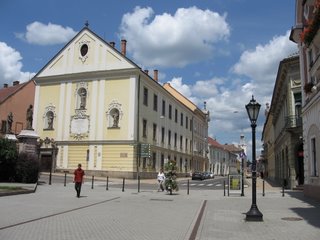 Baroque buildings in Széchenyi utca, Eger
Baroque buildings in Széchenyi utca, Eger Statue commemorating the battle against the Turks in 1552, Eger
Statue commemorating the battle against the Turks in 1552, Eger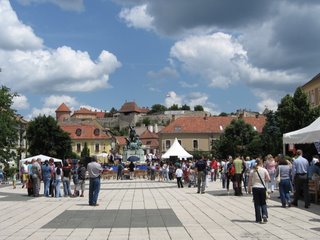 Dobó István tér with the castle behind, Eger
Dobó István tér with the castle behind, Eger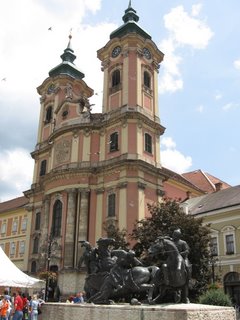 Church of the Minorites, Eger
Church of the Minorites, Eger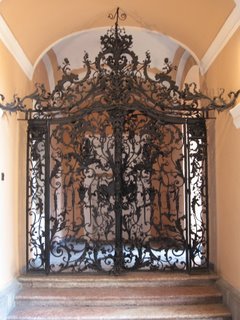 Wrought-iron gates at County Hall, Eger
Wrought-iron gates at County Hall, Eger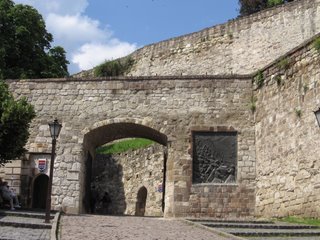 Entrance to the castle, Eger
Entrance to the castle, Eger View of the town from the castle walls, Eger
View of the town from the castle walls, Eger Minaret seen from the castle walls, Eger
Minaret seen from the castle walls, EgerThe streets have been filled with people and there seem to have been countless events happening at different locations around the town. We have watched traditional Hungarian folk dancing at the foot of the cathedral steps, along with a brass quartet playing Beatles music. We have also watched a whole series of events on the main square with children in Hungarian costume, a group of handicapped children dancing and singing in an incredibly lively, happy way that had the audience joining in with them while their mentor not only led them in the performance but accompanied the words using Hungarian sign language for the deaf. We also watched what looked as if it were intended as Hungary's entry for the next Eurovision song contest! Watching the youngsters gyrate to western techno-music we recalled that when we first visited Hungary, back in the days of communism, such music and such dancing would have been regarded as western decadence and not permitted.
 Folk dancing at the book fair in front of the Cathedral, Eger
Folk dancing at the book fair in front of the Cathedral, Eger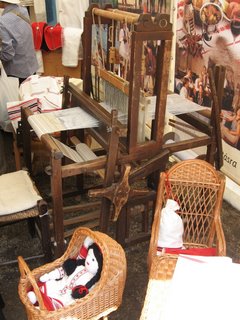 Weaving traditional textiles at the craft fair, Eger
Weaving traditional textiles at the craft fair, Eger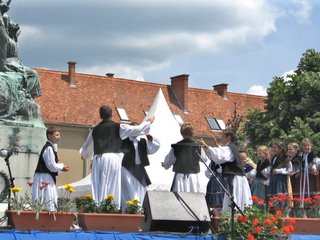 Children folk dancing, Eger
Children folk dancing, Eger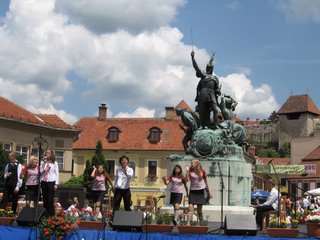 Hungary's entry for the Eurovision song contest? Eger
Hungary's entry for the Eurovision song contest? Eger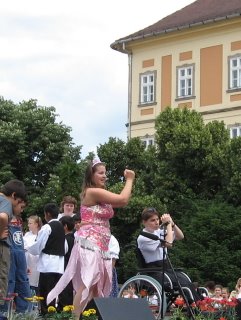 Entertainment from disabled young people, Eger
Entertainment from disabled young people, EgerSince we discovered the Manhole Cover Museum in Italy we spend as much time peering down at the pavements as we do at the surrounding architecture. In Pecs we commented that many of the drain covers were missing. At Eger they appear to have solved this common Hungarian problem by using covers from other towns and cities! Be warned citizens of Esslingen am Neckar, somewhere on your streets is an open manhole!
 Genuine local manhole cover, Eger
Genuine local manhole cover, Eger Purloined manhole cover from Esslingen am Neckar, Eger
Purloined manhole cover from Esslingen am Neckar, EgerIn the brightly decorated cathedral with its domed painted ceiling and orange Corinthian columns the pews began to fill with people arriving for the midday mass. Suddenly the entire space of the Cathedral reverberated with a magnificent penetrating wave of sound as the organ announced the start of the service. In the midst of this awesome moment we were accosted by someone shaking our hands and telling us in German how delighted he was to see us again! It took a second before we remembered the Dutchman we had met at the campsite at Keszthely on Lake Balaton! The common language of communication on most campsites in Hungary is German. Being a relatively small country with few campsites it is not altogether surprising we should bump into people we've already met from time to time.
Restaurant food in Hungary, as we may possibly have mentioned, is excellent and compared with Britain, very cheap. So we are encouraged to eat out far more than we would normally do. Today we sat under a shady umbrella on the terrace of a busy restaurant and enjoyed huge meals of Wiener Schnitzel and salad (Jill) and pork in an onion and paprika sauce with fried potatoes (Ian). We also had glasses of the local Eger red wine and bottles of iced water. The total bill was around £10.
The afternoon has been almost too hot for comfort. We discovered a good way to keep cool when we visited the "Town beneath the town". This is a huge complex of tunnels beneath the Bishop's palace in which the wines of the church used to be stored in the 18th century. Wine then was equivalent to currency with the wealth of the Church invested in barrels of quality wines. There are around 90 km of tunnels under the town, several levels deep! Later they were no longer used, fell into disrepair and were closed off. Unfortunately the mortar dissolved and the network of caves – like an emmental cheese beneath the town – became dangerously unstable. During the communist period the walls were roughly shored up with concrete but water has continued to flood in ever since without an adequate system of drainage. Apparently there is a real risk that the beautiful baroque buildings of the town above could collapse unless a way is found to prevent water seeping in and dissolving the lime in the cement.
Back into the heat of the town again we made our way to Szépasszonyvölgy (the Valley of Fair Women - Hungarian is not the easiest of languages to guess at!) where our campsite is situated. Beyond, there is a pleasant, shady valley with a stream and grassy areas for family picnics and barbecues. There are also several little country restaurants serving meals at outside tables and dozens of small cellars where you can sample glasses of the wines as you sit outside beneath the cool trees and listen to lively gipsy music played by a quintet on a neighbouring terrace. Stalls had been set up selling sweets, biscuits, melon seeds, gingerbread and little souvenirs – painted ceramic eggcups, wooden toys such as dolls, pecking birds and little flutes.
Weary from the sun and so much walking we returned to Modestine around 7pm where it was still warm enough to sit outside for a light supper in the warmth of the evening. It seems to get dark quite early here – around 8.30pm at present.
Tomorrow we move on towards Budapest.
Monday 12th June 2006 Tahi by the Danube, Hungary
Well we have not quite made it to Budapest yet, mainly because we keep discovering interesting places on the way.
Linguistically Hungary it is a very strange place. Here, "hello" means "goodbye"! Yes it really does. We were intrigued when we first heard it but have become accustomed now to people saying Hello as they take their farewells of friends. The Beatles' song was meant just for them! Here too "tej" means milk, not tea, and "bor" means wine not beer. We are slowly beginning to understand some signs, menus and directions but really the most useful skill here is an understanding of German. We would be quite lost otherwise as English definitely takes second place. As soon as people see our GB plates they start to speak German!
We left Eger and have spent most of this hot sticky day travelling along the winding roads through the hills, right up against the Slovak border. The countryside has been delightful – not stunning but very pleasant with undulating, forested hills, open fields, straggling villages with houses set back from the roads, edged with ditches and grass verges. The roads have been abominable, being full of deep potholes every few yards, scattered across the entire road surface. Fortunately traffic has been sparse and we have travelled slowly, weaving our way around the dangerously deep ruts and holes in the cracked tarmac.
At Szécsény, a small town, barely more than a village, we stopped for lunch for the three of us, Modestine requiring a few litres of diesel. We had difficulty finding an Etterem but when we did the place was filled with local people and there was only one choice on the menu. Fine by us as we had little idea what we would be served anyway. Under a shady awning in the garden we were served a soup containing potatoes and pearl barley. Everyone eats soup all year round in Hungary. This was followed by pork cutlet with onions and peppers served with rice. It was really very acceptable and the price was 550 forints each – less than £1.50! Unbelievable but true! The little town of Szécsény boast a beautifully restored baroque castle, now used as a museum, and a mediaeval Franciscan monastery.
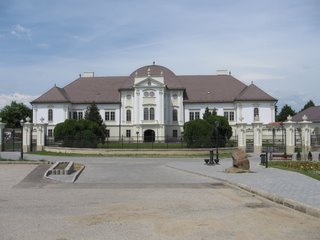 Castle at Szécsény
Castle at SzécsényHaving stocked-up on essential shopping and an unessential but delicious bag of dark red cherries we continued towards Vác where we understood from our map that it was possible to take the ferry across the Danube. For a while our route followed the border with Slovakia, following the river and skirting pine forests with fields of arable crops along the roadsides. Out in the wilds of the countryside, on three occasions we passed young ladies wearing very little standing in provocative poses in lay-bys. At first we found it amusing but have since wondered how they came to be there with no transport. We wonder whether they are actually Rumanian rather than Hungarian and had been dropped off there by their pimps. What a sad and unpleasant way to earn a living. From what we have been told of the situation in France by our nun friends at the convent in Normandy, it would seem that such Romanian girls are almost held captive by the pimps who manage them. Not having legal papers they cannot break free from the trap in which they have become caught.
Eventually we arrived in Vác and, using our burgeoning knowledge of Hungarian, we found our way to the little ferry through the back streets. Leaving Modestine on the banks of the Danube we explored the town where we found an internet café. These are often few and far between so we take the opportunity when we can. The internet is our umbilical cord to the real world beyond our self-indulgent travels. We open our email with a mixture of dread and joy. The pleasure we receive from messages from friends and family cannot be imagined by anyone who has not spent months in isolation travelling in a land of strangers with little understanding of local language and customs. The aggravation of dealing with troubles concerning insurance policies, banks, outstanding premiums, car insurance renewals etc can be imagined only too well. Generally things run reasonably smoothly, but today has been particularly frustrating. Finding time to load on a blog when America is awake and busy can also be infuriating. To cap it all, today we received the traumatic news that sadly our adopted cow Souris in Livarot "a malheureusment quitté pour le paradis des vaches, mais sa descendante est heureuse de devenir votre filleule." We can apparently meet Abeille on the 26/27th August when the farm has an open day (and barbecue?). So one way and another we spent nearly two hours on the internet sorting things out and emerged in time to miss the ferry across the Danube.
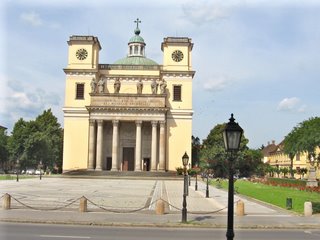 Cathedral at Vác
Cathedral at VácNem baj – never mind. We waited for the 7pm crossing eating ice creams. Dusk began to fall over the blue hills towards Slovakia and the reaches of the Danube below the Hungarian-Slovak border as we sat by the river remembering the first time we passed this way, back around 1970 when we took the hydrofoil down from Vienna to Budapest to meet Hubert. Strange that we had been on this very stretch of the river before!
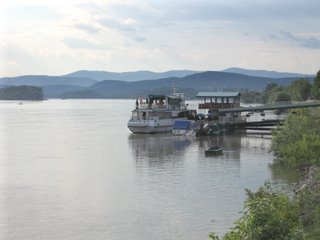 Blue remembered hills
Blue remembered hills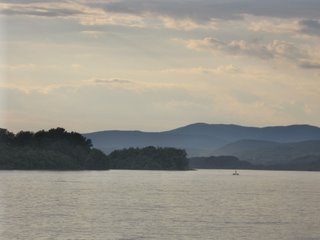 Magic moment
Magic moment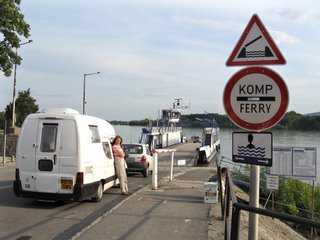 Modestine and Jill wait to board the ferry
Modestine and Jill wait to board the ferry Modestine crosses the Danube
Modestine crosses the DanubeBrittany Ferries is proportionally cheap compared to the cost of crossing the Danube on a ferry not dissimilar to the one at Torpoint on the Tamar! The four wheel drive in front of us was charged as a car but poor Modestine had to pay double as a camping car despite being smaller! As the ferry man explained, she was a "kicsi cocsi". Sounds sweet doesn't it? The ferry dropped us on a large island in the river. It is linked to the further bank by a bridge.
We are hoping to look at Esztergom and Visegrád before we reach Budapest. So we have camped for the night just across the water on the far side of the Danube which laps the banks only a few metres from us. The lady on the campsite speaks good German and has told us that only a few weeks ago the river level rose and flooded the site to a depth of several metres. After a very hot and humid day it has started raining. Let's hope we sleep peacefully and stay dry in our bed tonight!
Tuesday 13th June 2006 Esztergom, Hungary
This morning we continued our travels to Visegrád on the Danube a few miles north of last night's campsite. The little town is delightful. High above on a rocky promontory stands the remains of a castle overlooking the Danube bend where the fast flowing waters pass through wooded hills with the little town of Nagymaros on the opposite bank. There is a ferry here as well as the one we used at Vác yesterday. This one looks more exciting, being nothing more than a floating platform on which vehicles are carried across the wide expanse of water, guided by a little boat that provides the necessary power. It looks rather risky really so perhaps Ian was wise to have suggested we use the Vác ferry yesterday.
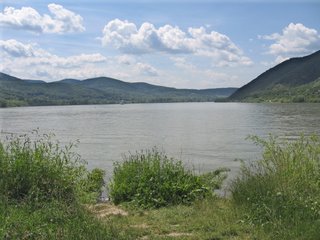 Typical scenery on the Danube bend, Visegrád
Typical scenery on the Danube bend, Visegrád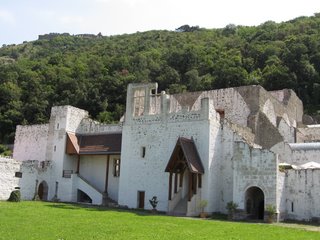 Mediaeval royal palace with castle above, Visegrád
Mediaeval royal palace with castle above, Visegrád Ferry to Nagymaros, Visegrád
Ferry to Nagymaros, VisegrádThe day has been extremely hot - the sort of day that completely drains one of energy. The thought of climbing up to the castle daunted even Ian – to Jill's relief. We have visited it in the distant past and have a written account in any case.
Visegrád was teaming with children. There seem to be an incredible number of them in Hungary at present and thousands seem to have converged on this little town with not obvious motive other than playing in the park, queuing at the ice cream stall, gathering at the gates of the castle and generally having a happy time away from the classroom. They all seemed rather sweet and very well behaved. There were dozens of coaches on the outskirts of the town, each class of children having their own vehicle. There was presumably an educational motive to the day but it was not apparent.
 A great day out, Visegrád
A great day out, VisegrádWe found a tiny little café we once used on a previous visit when we took shelter from the rain and spent an hour eating bableves – bean soup. We have always recalled that visit with pleasure and today it seemed to have changed very little. We were able to eat the menu for the day under a sunshade outside on the street with crowds of children passing back and forth behind us. Lunch consisted of a noodle soup followed by deep fried breaded camembert type cheese with rice and salad. It was ample and cost 540 forints each – less than £1.50!
The streets of the town are quite rural with little, single-storey houses set in shady gardens with vines, fruit trees and vegetable patches. There is a little stream beside the street which is tree-lined and many of the houses offer rooms for holiday rent. Unfortunately, in common with most towns in Europe, unsightly electricity cables are festooned along the streets and the house fronts. But that's a photographer's moan.
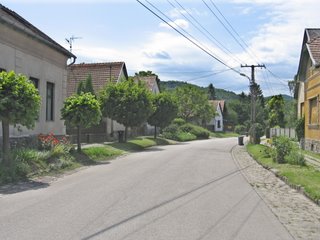 A street in Visegrád
A street in Visegrád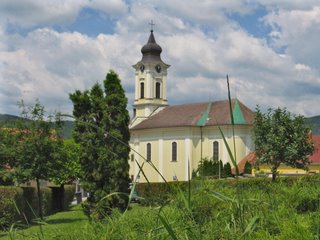 Holy Trinity Church, Visegrád
Holy Trinity Church, VisegrádWe continued a further 26 kilometres beside the Danube to Esztergom. At this point the river forms the boundary between Hungary and Slovakia. The centre of Esztergom is dominated by the huge cathedral or basilica and the castle ruins, set together on a high promontory overlooking the river. Built between 1822 and 1856 the Cathedral has a colonnade of huge pillars fronting the portico and an enormous cupola that makes the interior very light. Inside the walls are faced with a variety of different coloured veined marbles ranging from orange and red through to dove grey, creamy yellow and pale blue touched with pink. The building is very extravagant with a huge organ surrounded by elaborately carved stone angels playing musical instruments – including one we noticed playing a real trombone! There are several side altars as well as the main one, all of which make elaborate use of marble, gold decoration and carved woodwork. The church is dedicated to the tenth century St. Stephen and there is a reliquary with a skull, supposedly his, on one of the side altars.
 Cathedral, Esztergom
Cathedral, Esztergom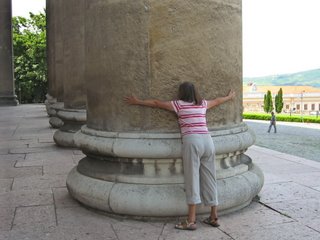 Large is the word that best describes the Cathedral, Esztergom
Large is the word that best describes the Cathedral, Esztergom Main altar in the Cathedral, Esztergom
Main altar in the Cathedral, Esztergom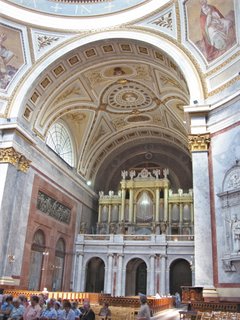 Organ in the Cathedral, Esztergom
Organ in the Cathedral, Esztergom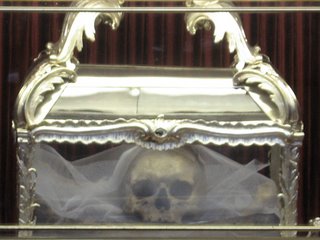 Skull of St. Stephen, Esztergom
Skull of St. Stephen, EsztergomThe importance of the basilica at Esztergom is that it is the seat of the prelate of the Catholic church in Hungary - equivalent to our Archbishop of Canterbury and the Cathedral there.
It was blissfully cool inside and delightful just to sit and steam gently, looking around at the ceiling paintings with out binoculars. Descending into the crypt it became too cold for comfort! We shivered as we looked at the tombs and monuments. Here there are photos of Pope John Paul II praying at the tomb of Cardinal József Mindszenty who in his lifetime had been persecuted and imprisoned by the communist regime for speaking out about freedom and civil liberty for fellow Hungarians.
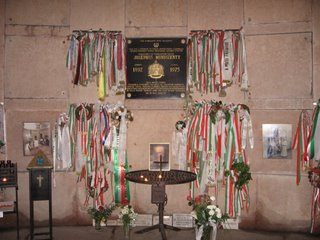 Tomb of Cardinal József Mindszenty, Esztergom
Tomb of Cardinal József Mindszenty, EsztergomA wall of suffocating heat met us as we emerged into the bright sunlight. From the nearby castle wall we could see across the Danube to Slovakia and the little town of Stúrovo on the far bank. We looked out at the same view back in the early 1970s when we were here with Hubert, our East German friend. In those days the communist regime ensured that there was no easy communication between the two countries. A bridge had been partially blown up during the war and never rebuilt. Ever since the two countries had been able to see each other across the water but there was no communication. We have photos of this destroyed bridge back home. In 2001 though, the bridge was finally rebuilt and now spans the entire river so that people can travel freely between Esztergom and Stúrovo. It was an exciting, rather emotional moment for us seeing the new bridge – a potent symbol that Europe really is uniting, physically as well as politically and economically!
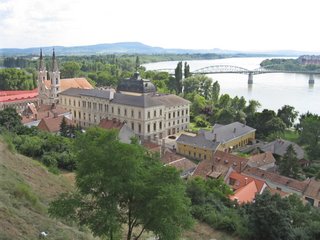 Towards the completed bridge from the castle, Esztergom
Towards the completed bridge from the castle, EsztergomHaving made our way down to the lower town and explored its pretty streets with several ladies sitting at their doors crocheting or embroidering table linen with bright traditional designs, we made our way up on to the new bridge. The sun was still far too hot but we were determined to cross the river at the point where in the past we had felt angry that people's lives were made so drab and difficult because it suited the political aspirations of the Soviet regime. The bridge spans possibly the widest river we have ever walked across and offered us a new perspective of Esztergom with wonderful views of the cathedral and the ruined castle high above the river, where large pleasure boats and commercial barges plied up and down in the fast-flowing current.
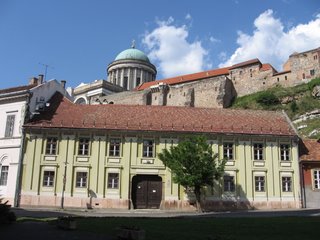 Looking up from the old town, Esztergom
Looking up from the old town, Esztergom View from the bridge over the Little Danube, Esztergom
View from the bridge over the Little Danube, Esztergom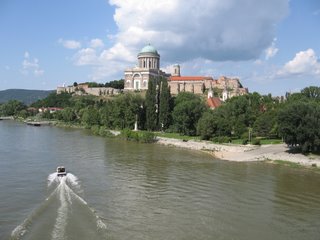 View from the bridge over the main Danube, Esztergom
View from the bridge over the main Danube, EsztergomAt the Slovak end of the bridge we were asked for our passports. Customs control is used to Hungarians and Slovaks walking back and forth but the official looked rather bemused as we handed him our British passports when we were obviously carrying no luggage whatsoever. As he did not seem to speak English though, after a brief discussion with colleagues our passports were returned and we walked on into Slovakia.
We had no local money and were not even sure what language is spoken there. So we followed the road into the centre of the little town and spent a pleasant hour just looking at the crowds of people in the streets and parks, and tried to work out how much the currency – whatever it is – is worth, judging by prices for ice-cream and beer, assuming them to cost about the same as Hungary. We did learn the Slovak for men and women when we searched for a toilet, but as the doors were locked and we needed to ask for the key at the café where we were expected to buy a drink, we gave up, daunted by thoughts of trying to explain our predicament.
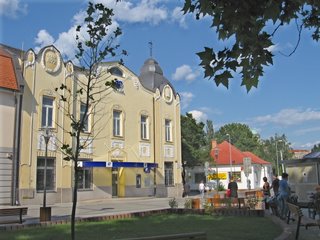 Our only view of Stúrovo, Slovakia
Our only view of Stúrovo, Slovakia 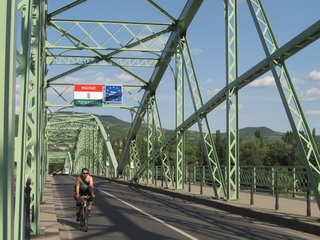 Open borders, the bridge linking Hungary and Slovakia, Esztergom
Open borders, the bridge linking Hungary and Slovakia, EsztergomWe returned to Hungary and rejoined Modestine. According to the map and the sign boards there was a campsite high in the hills above Esztergom with stunning views across the river and surrounding countryside. When we arrived, the sign on the gate said zarva (closed).
So down we came again and eventually found our present site on the banks of the river opposite the basilica. Jill's hopes of a swim in the site pool were dashed as it closed for the evening just as we arrived. Hot and sticky we sought out the showers. While we were there thunder crashed and the rain started. It didn't last long but has cooled the air wonderfully. A relaxed supper outside was accompanied by black skies, rolling thunder and billows of white cloud over the green cupola of the basilica. The sunset caught the gold cross on the top of the dome which shone brightly against the dark sky. As the light faded the floodlights came on. We will be able to sit in bed and see the illuminated cathedral through Modestine's back window!
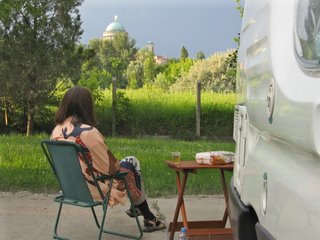 Cathedral from our "home," Esztergom
Cathedral from our "home," Esztergom